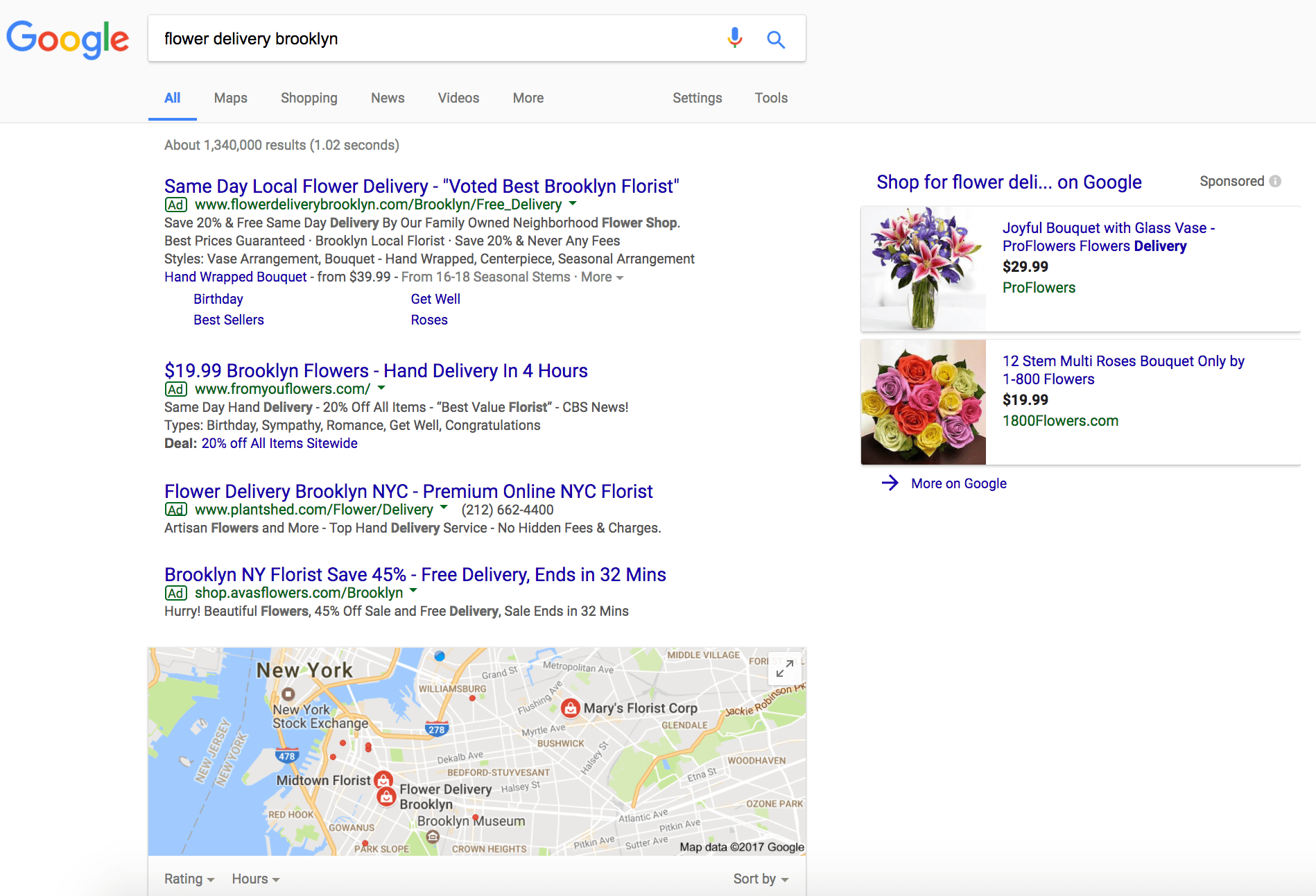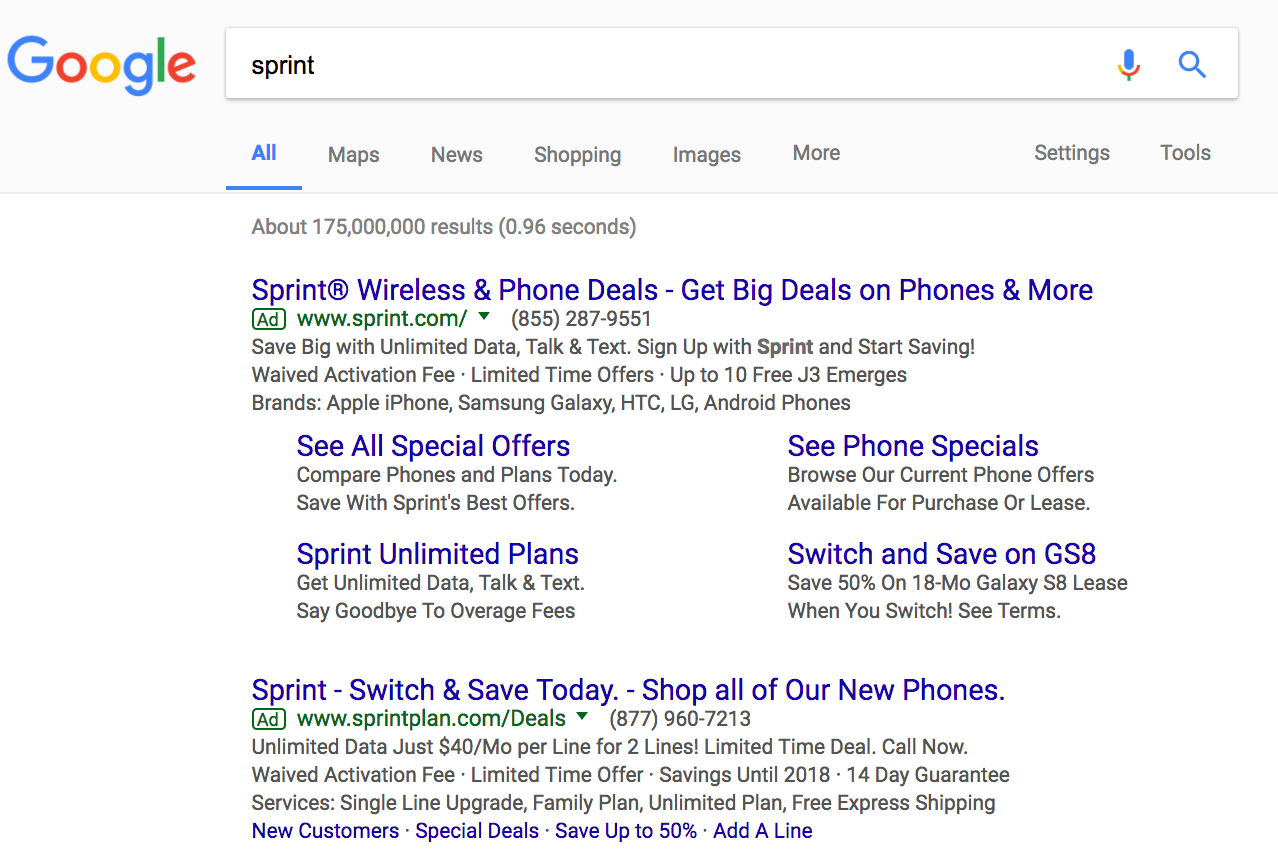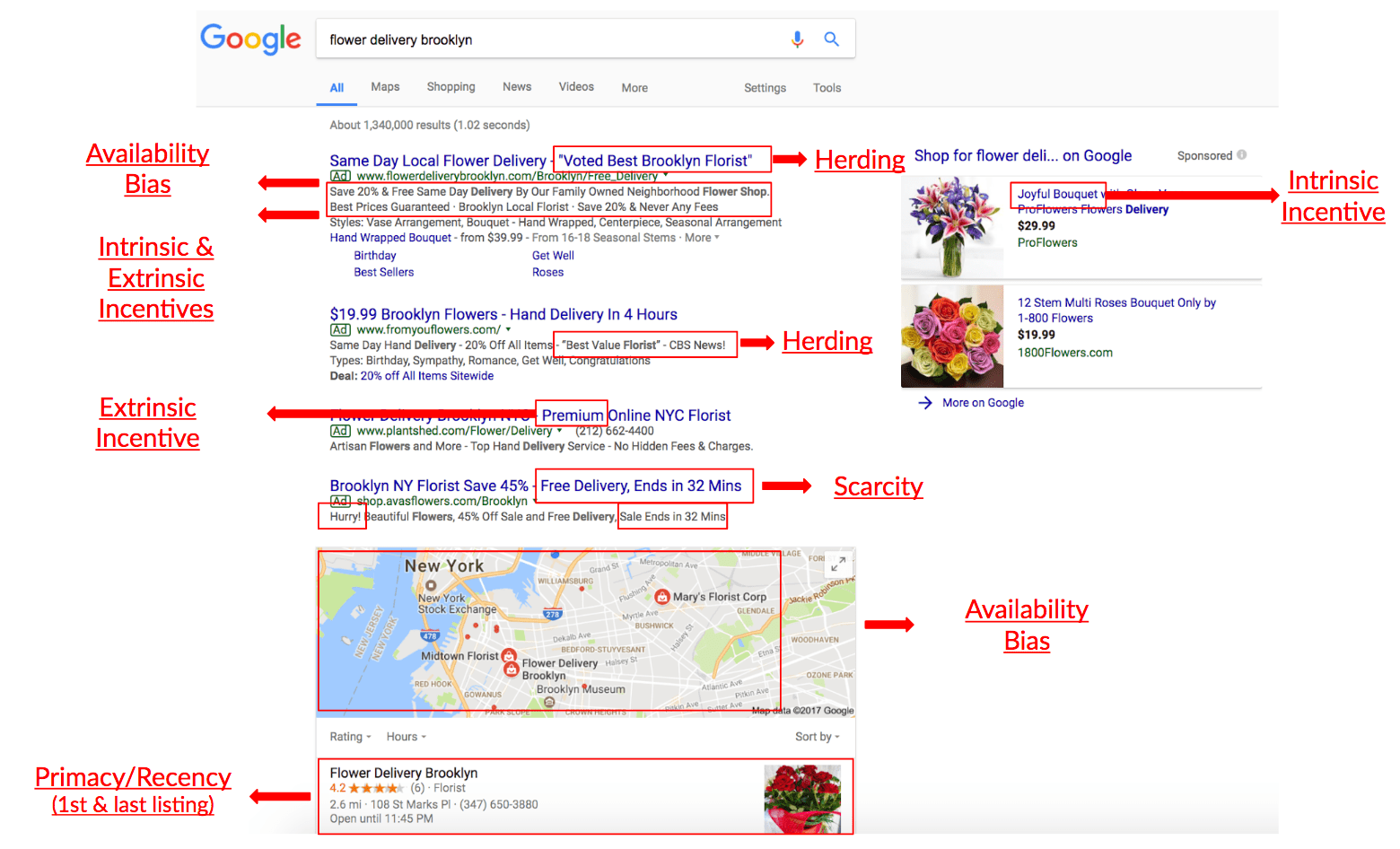Here’s a typical search engine results page:
Wow. There’s a lot more going on here than meets the eye. Do you see it?
Every ad here is vying for a click. So how will people decide which ad to click on – and ultimately make a purchase decision?
The best PPC ad here is the one that ultimately motivates a searcher to click.
We rely on data to guide us toward that all important click. After all, we have so much data at our disposal today.
But pure, hard data isn’t the answer in isolation. Actually, it’s the interplay between the rational and the emotional where we can have the most impact.
Why?
Humans Aren’t Rational Creatures!
People make snap judgments all the time and with good reason. To apply our full critical faculties to every decision would be exhausting and inefficient.
Moreover, rationality itself is a nuanced concept. We are rational to different extents and in different ways at various times of each day.
The level of rationality applied to decisions will depend on the product. For example, the behavioral factors behind choosing a pension will differ from those that drive our choice of Mexican restaurant for dinner tonight.
So if we agree humans aren’t rational, then how can you ensure as many of them as possible click on your PPC ads?
With some motivation.
Here are three powerful motivators you can exploit for better PPC ad copy that converts.
Motivator 1. Incentives
Incentives are behind pretty much everything we do. They are the reason we go to work, tchoose certain brands over others, and eat at particular restaurants.
These concepts typically come in two forms:
- Extrinsic incentives: These relate to factors outside of the self. For example, I go to work because I need the paycheck to pay rent and I enjoy the status my title affords me.
- Intrinsic incentives: These come from within and can often be more powerful motivators. For example, I go to work because I feel like I am contributing to society and I enjoy what I do.
Advertising has always played to these incentives.
In other words: What’s in it for me? How will I feel, look, or live better if I buy your product?
How to Use Incentives in PPC Ad Copy
Incentives should play a significant part in any PPC campaign. You’re fighting for attention in a crowded space. The quicker your offer can demonstrate incentives, the better.
The line between extrinsic and intrinsic incentives is often blurred, as we can see in the ad copy for [charity donation]:
All worthy causes. All deserving of support. All competing for our attention.
The intrinsic incentives are clear: “Children Need Help”, “End Childhood Cancer”, “Support Cancer Research”, to cite just three examples. We would all like to contribute to these causes.
However, there’s an awareness that perhaps donations are not always purely selfless acts. There are extrinsic incentives behind donations, too. Note the mention of “100% Tax-Deductible” in there.
These examples of ad copy demonstrate a sophisticated understanding of just how muddled our incentives can become.
At other times, the distinction is clear.
For an overtly commercial search like [mens jeans], we can see which tactics are employed. These ads play to extrinsic incentives, with nods to our desire to be seen as fashionable (“The Seasons Best Looks”) but also to find value within our financial range (“At Affordable Prices”).
There are, however, numerous attempts to appeal to intrinsic incentives. Of note are phrases like “Made Ethically”, “Personal Freedom”, and “Stop Paying Retail Markup”.
Consumers want more from a product than just the latest styles. They want to feel ethically responsible, they want a sense of buying into something greater than just the material, and they also don’t want to feel like they are being ripped off.
Key takeaway: We should always be asking what is most likely to motivate our audience. We should also understand that this will differ by product set, by time of day, and by demographic.
Motivator 2: Herding
People are conditioned to learn from the experience of others. Deep down, there’s an assumption that the wisdom of crowds will guide you toward a quick, safe decision.
Parallels of this form of decision-making are found everywhere in nature.
Penguins in the Antarctic face a daily dilemma, as they are in the middle of the food chain. Should they dive into the water in the hope of finding krill, but simultaneously invoke the risk of being eaten by a seal? There’s no way to be certain.
One penguin takes the plunge and the others make assumptions based on the outcome. Should their flightless friend emerge unscathed with a beak full of beautiful krill, the others will follow suit. If not, well, they hold back the hunger pangs a little longer until the coast clears.
This is a slightly more important decision than choosing which PPC ad to click on, but the underlying principle is the same. People are suspicious of brands they’ve never heard of and that have no customer reviews. People also want someone else to take the plunge and report back to base.
Although most people still trust media outlets, in this cynical age many people are more likely to trust their fellow consumers.
How to Use Herding in Ad Copy
Remember that people want all the necessary information to make a decision at their disposal, as effortlessly as possible.
Reviews matter. Use them in your ads if they are available.
Make full use of ad extensions to include your company’s USPs and reassure the consumer that you’re a reputable provider. This provides a sense of security in the knowledge that many other consumers have used and enjoyed your services.
We can see this in action if we look at the results for [red sox tickets]:
There are not only reviews but also quotes from sources like the Washington Post. Ad extensions are used to include consumer ratings on service and website quality, too.
People are sometimes concerned about buying event tickets online, but these ads show that they are in safe hands. Others have entered the waters and returned unscathed.
Motivator 3: Availability Bias
People reach for the information that is most readily available when making most decisions.
We all have a repository of past experiences and knowledge that we use to cut through the noise and reach snappy conclusions. This is known as the availability bias. It is considered a bias because it tends to lead us to irrational choices based purely on the first relevant piece of information we think of.
The availability bias is related to psychological phenomena known as primacy and recency. These concepts state that we tend to recall the information we heard first and last, but rarely the information in between.
The applications of such a theory for search are self-evident.
How to Use Availability Bias in Ad Copy
Make decisions as easy as possible for customers. You can do this by demonstrating how close your store is to their location or how simple your shipping process is.
Also consider how you communicate with existing consumers. If they have shopped with you before, they are more likely to do it again. This should be a central consideration as you try to attract repeat customers.
Looking to primacy and recency, you can test your ad positions to see if it makes the most sense to rank first in PPC and first in SEO. We may perform more cost-effectively in the fourth position for PPC and first for SEO, for example.
We could also go against the grain. Availability sometimes leads consumers into decisions that are against their best interests. This is particularly true of more cumbersome decisions, like switching cell phone carriers.
We can see this in action for the query [sprint]:
The second ad is focused on convincing consumers to make the switch. They may be overpaying for service with another carrier out of habit, so Sprint makes overt reference to the savings it provides and also the ‘Waived Activation Fee’. Mentioning a limited time offer also plays into the scarcity effect – or FOMO (fear of missing out) in modern parlance – to add a sense of urgency to proceedings.
We can learn from this that while cognitive biases can be used to guide users on an unconscious path, we can also awaken them from the slumber of irrationality if we have a better deal to offer.
Bringing It All Together
Now, let’s go back to the earlier example of search results for [flower delivery brooklyn] and apply what we’ve learned.
Now it’s clear to see all the motivators at play.
Sometimes we simply know these things intuitively and include them within ad copy. However, familiarizing yourself with these concepts can add more rigor to your testing.
Adding some powerful motivation can significantly improve your ad copy and PPC campaign performance.
Image Credits
Featured image: Pixabay
In-post image 1: Unsplash
In-post image 2: Unsplash
Screenshots taken by Clark Boyd, May 2017.
Go to Source
Author: Clark Boyd
The post Exploit These 3 Powerful Motivators for Better PPC Ad Copy by @clarkboyd appeared first on On Page SEO Checker.
source http://www.onpageseochecker.com/exploit-these-3-powerful-motivators-for-better-ppc-ad-copy-by-clarkboyd/








No comments:
Post a Comment